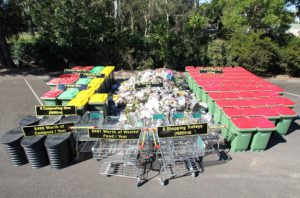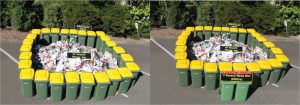
September 26, 2013
Ever Wondered What Your Household’s Annual Waste Would Look Like?
 We all follow the weekly ritual of wheeling our various household MGBs along their well-worn path to the pavement for convenient council collection. Most of us probably even very briefly consider our weekly volume of waste, particularly after those family events which seem to so quickly fill the recycling bin with empty beer and wine bottles, and have the green bin overflowing with wasted food scraps.
We all follow the weekly ritual of wheeling our various household MGBs along their well-worn path to the pavement for convenient council collection. Most of us probably even very briefly consider our weekly volume of waste, particularly after those family events which seem to so quickly fill the recycling bin with empty beer and wine bottles, and have the green bin overflowing with wasted food scraps.
However have you ever considered just what your family’s annual household waste would look like? Surely just a glimpse would motivate most of us to consider even more carefully how we can further minimise household waste and importantly divert more from landfill…
As part of Sunshine Coast Council’s innovative approach to waste, the team has recently completed an insightful program which aims to show their local households just how much waste is generated annually. As Jim Straker, Waste Strategy Coordinator, highlighted, the project aim was to “open people’s eyes to the total waste management service provided by council over the year, and I am sure these pictures do that!” he added.
Indeed I found it impossible to view the following pictures without considering my own family’s environmental footprint this year….
In Australia 98% of households now participate in some type of recycling. This trend reflects Australian families willingness to be activity involved in more sustainable practices, yet there is still enormous opportunities for improvement, and increased awareness and education is the key!
Sunshine Coast Council similar to many local councils, can collect 19 m³ per household annually if the three bins are being used by the householder. To borrow a commonly used analogy, that means it would only take two and a half households to fill up an average backyard pool, every year.

The team run three collection services, general waste (landfill), recycling and green waste, which are broken out in this second picture. On average households generate 6m³ of both recyclable
Green Waste and Recycling, and only 7m³ of general waste.
There are 26 Green Waste (240 Litre) bins collected from households in the Sunshine Coast each year, which equates to 6m³ of material annually. The contamination rate is approximately 8% which equates to two general waste bins.

26 Recycle (240 litre) Bins are also collected from households each year, which equates to 6m³ of material annually, and similarly, the contamination rate is approximately 8%.

The General Waste stream is indeed the most interested to review. The Sunshine Coast Council collected 52 (140 litre) General Waste Bins equating to 7m³ of material. The picture shows just how much residual waste would be remaining for landfill if people simply avoided waste generation and used the right bin. This presents an enormous opportunity for improvement, with better education and more sustainable actions by local families.
Annually this would be:
– 8 recycling bins worth of recyclable material
– 6 green bins of additional green waste
– 6 compost bins – That’s $400 worth of compost, enough to make any garden thrive!
– 8 shopping trolleys of food waste – $681 worth, easily better spent on the family!
What remains, 15 (240 litre) or 20 (140 litre) residual general waste bins. That’s a reduction of over 70% for a household already recycling! If we were to consider the benefits of a focus on avoidance, reuse and community initiatives such as more sustainable packaging, this could be reduced even further.
So with all that in mind, is it time you took a second look in your general waste bin?